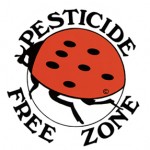Think before you spray
Posted on April 28th, 2009 by Phuong
It’s tempting for many of us to pull out the heavy-duty bottle of pesticide when we find insects, diseases or weeds in our landscape. We want the problem to go away, and go away fast, whether it’s powdery mildew on our squash or aphids on our roses. But before you bust out the sprays, consider that pesticides are toxic to pets, birds, bees, and fish, and end up in our waters. (Check out the Washington Toxics Coalition site to read more about it).

You can adopt a more gradual approach to dealing with pests and plant diseases by identifying the problem and then trying less-toxic methods of getting rid of it. You’ll often hear people call this process IPM, or Integrated Pest Management, but really it’s about using common sense to tackle the problem.
First, identify the problem. It’s possible that it’s not a nasty disease attacking your plant, but symptoms that you’re watering too little or too much. Or you may find out that the bugs in your garden are actually good, beneficial insects such as lady bugs and lacewings that eat bad bugs.
Once you’ve identified what’s wrong, find the least toxic way to get rid of it. Aphids, for example, can be controlled by hosing the plant down with water. Other pests and weeds can be removed simply by hand-plucking them from the plant.
Prevention is also a good way of keeping these problems at bay. Pick plants that are disease resistant, thrive in your climate, and grow well in the site you chose for it. Reduce plant stress by watering, pruning and fertilizing properly. Use barriers like mulch to suppress weeds or floating row covers to keep bugs away. Check out these fact sheets on less toxic ways to deal with snails & slugs, spider mites, roses, and more.
Filed under:Seattle Landscape Design, Seattle Landscape Maintenance, Seattle Lawn Care | Permalink |
2 Comments (Go to comments form)
RSS feed for comments on this post · TrackBack URI




Posted by M. D. Vaden of Oregonm
May 1, 2009 @ 8:10 am
My use is limited, but I go for the “light-duty” pesticide bottle.
It is nice when we can pick the weeds. Less herbicide, plus a bit more stretching and excercise, although still inconsequential to the pollution our autos generate via manufacture for our use, plus our operation. But every bit helps.
One “baby step” that people can use to reduce pesticides, is increased FREQUENCY of spraying. That for the folks who are not ready to give up the spray wand but want to reduce chemicals.
Waiting for weeds to get big and spraying foot diameter weeds puts more mist into the air and on soil. Like waiting months. But if someone goes out every week or two, it barely takes any product to put a dab on a weed the size of a quarter. So increased FREQUENCY does not mean increased volume.
Especially for weeds with roots going into a sidewalk crack. Or with small weed trees that have rooted into a shrub like an azalea where the weed can be removed very easily.
M. D. Vaden of Oregon
Posted by Andy
May 1, 2009 @ 6:02 pm
Thanks, M. D. The same strategy applies for hand pulling weeds – get them early, get them young.